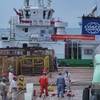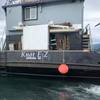Sea Containers Ltd., the transport group engaged in marine container leasing, manufacturing, depot
and logistics operations, railways operator, ferry operator and leisure
industry investor, issued a statement today about a major restructuring of
its ferries division and other matters.
Background The company's ferries business is composed of three units. The
largest is Silja Oy Ab, the Finnish based leading Baltic operator of cruise
ferries, ro-pax ships, fast ferries and cruise ships. The second is the
company's car-carrying fast ferries business with 9 ships operating in
European waters other than in the Baltic. The smallest unit is SeaStreak, the
New York based commuter ferry service operating between New Jersey ports and
Manhattan.
In 2005 the profits of Silja have declined significantly, due to a
combination of higher fuel costs which could not be recovered except on
services to Estonia, the unsuccessful m.v. Finnjet operation between Germany,
Estonia and Russia, reduced profits from duty free sales and overcapacity in
the Swedish market introduced by competitors. However, Silja still remains
the leading operator in its region with an excellent brand name and
reputation for quality, with its core business remaining profitable.
The company's car-carrying fast ferries incurred losses in 2005, due in
large measure to high fuel prices. The ships burn light fuel which has
doubled in price over the 2004-2005 period and it has been impossible to
recover the extra cost through fuel surcharges. Other factors have impacted
earnings. The ferry routes between France and England across the English
Channel have suffered from declining passenger and car volumes, excess
capacity and reduced profits from low tax merchandise sales. The company's
subsidiary, Hoverspeed, operates between Dover and Calais in the English
Channel.
SeaStreak, operators of services employing 7 foot-passenger only fast
ferries on three routes between New Jersey and Manhattan has also incurred a
loss in 2005 due largely to high fuel costs. Passenger fares are being
steadily increased to recover the extra cost but the market will only absorb
such increases to a certain level before switching to cars, buses and trains.
In light of the situation described above, the board of Sea Containers
met on November 2, 2005 and has decided to take measures that should
eliminate or greatly reduce the operating losses being incurred.
In the case of Silja Oy Ab, the company has decided to entertain offers
to buy the business. Societe Generale has been appointed to conduct a
controlled auction of Silja. In order to restore Silja's health, a number of
steps are being taken to improve operating results. These are:
1. The cruise ship m.v. Walrus will be sold preferably or if sale cannot
be achieved on satisfactory terms, it will be chartered out. The ship has
recently ended a long term charter and is having off-hire rectifications at
charterers' expense in Singapore.
2. The Swedish flag cruise ship, m.v. Silja Opera will be sold preferably
or if sale cannot be achieved on satisfactory terms, the ship will be
chartered out for operation outside the Baltic without high cost Scandinavian
manning. The ship will operate in the Baltic until February, 2006, relieving
the ships Silja Serenade and Silja Symphony which will be undergoing three
year surveys and docking at that time. Silja regrets the loss of the Silja
Opera which has established a good market following, but trade unions have
been slow to allow manning conditions which would enable the vessel to
continue to operate in the Baltic.
3. The m.v. Finnjet has left the Baltic and is currently on charter to
Louisiana State University Health Science Center through FEMA, based in Baton
Rouge, Louisiana. This vessel will not return to the Baltic. The vessel will
be offered for sale, or failing sale on satisfactory terms, it will be
chartered out. If chartered out, the ship's diesel engines may be increased
in power to allow 24 knots service speed which prospective long term
charterers have requested. The ship's hull was built for a 30 knot speed
using a combination of diesel engines and gas turbines but gas turbine
operation is prohibitively expensive in light of today's high costs for light
fuels.
4. The ro-ro ship m.v. Starwind has been sold for $5.4 million in the
fourth quarter, close to her book value.
5. Silja's three SuperSeaCat fast ferries will be reduced to two for
operation between Helsinki, Finland and Tallinn, Estonia. Financial
performance will be improved through better manning arrangements and other
operational measures. The third SuperSeaCat will be returned to Sea
Containers for deployment in the Mediterranean in 2006.
6. Silja's flagship service employing state of the art vessels Silja
Serenade and Silja Symphony, each with 2,852 beds, will be given a $12
million upgrade to freshen the product and increase their profitability. This
upgrade will be financed with asset sales or through mortgages on these
assets.
7. Silja's largest vessel, m.v. Europa, will continue to operate on the
Turku-Stockholm and Turku-Kappelskar routes together with m.v. Festival which
operates between Stockholm and Turku. Silja currently also operates two
roll-on, roll-off ships on the Turku-Stockholm route and these vessels are
capacity constrained.
8. Silja will be reducing its staff and offices in Finland, Sweden and
Germany, including up to 150 shoreside jobs at a cost of up to $10 million,
achieving annual savings of approx. $18 million.
Additionally, an action plan for improved internal cost efficiencies is
being implemented to achieve further annual savings of $10 million by the end
of 2007.
9. A restructuring charge of $70 million in connection with the plans
outlined above will be recognized in the fourth quarter of 2005. It is
expected that underlying debt or more will be achieved on asset sales. The
cash component of the restructuring charge will be $10 million or less.
In summary, Silja is being reduced to its core business of 8 vessels
operating on three routes. Silja's EBITDA for 2004 was $70 million and for
2005 after absorbing $22 million of extra fuel costs it expects to achieve
EBITDA of $39 million (excluding restructuring costs). EBITDA is expected to
improve in 2006 and 2007, assuming fuel remains at today's costs and
excluding restructuring charges. It is not possible to predict the sale price
for Silja.
Car-carrying fast ferries The company owns or part-owns 9 such ships. One
SuperSeaCat is on long term profitable charter. Two of the vessels are
operated in the Adriatic in a 50/50 partnership with the Mediterranean
Shipping Company group. It is planned to put a fourth vessel owned by Sea
Containers into the partnership from 2006. The company also operates fast
ferry services in the Cyclades Islands in Greece in 50/50 partnership with
the Eugenides Group. It is planned to introduce a second vessel into this
trade in 2006.
Sea Containers is no longer able to support Hoverspeed's losses on the
English Channel so it will not operate the Dover-Calais route in 2006 or
thereafter. Hoverspeed has commenced consultation with staff as required by
labor law, which will result in a significant number of redundancies. A
restructuring charge of $15 million will be established to cover the closure
of Hoverspeed's Dover-Calais services.
Two of the company's car-carrying fast ferries are older than the other
ships and were built to a different construction code than applies to newer
vessels. These two vessels are currently laid up awaiting charter or sale.
Some countries (but not major ones like the U.K., France and Italy) will not
permit vessels built to the older code to operate to their ports, thus
reducing the company's range of deployment possibilities. The company has
determined, therefore, to reduce the carrying value of the two vessels built
to the earlier code by $19 million in total and to sell the ships in due
course. Two sister ships built to the latest construction code are employed
in joint ventures in the Mediterranean where they will remain, however, the
board has determined to write them down by $15 million to estimated current
market value.
Despite the re-deployment or sale of car carrying fast ferries it is
unlikely that this business will cover its full costs in 2006 unless either
fuel prices decline or fuel surcharges can be collected to cover the high
fuel costs. However, this deployment is expected to improve significantly the
operating results from the car carrying fast ferry fleet in 2006. The company
will no longer operate any of these ships itself but instead will charter
them out to joint ventures or other operators.
SeaStreak The company has decided to entertain offers to buy this
business. In the meantime an action plan is being implemented to increase
prices to recover the extra fuel costs, to close the South Amboy to Manhattan
service and take a related charge of $2 million and to have the owners
charter-out or lay up the two older vessels engaged in this service.
SeaStreak time charters the vessels from local owners as required by the
Jones Act.
Sponsored Content
The Future of the Advanced Measurement Industry: A Vision of Precision, Safety, and Reliability

August 2025
 Read the Magazine
Read the Magazine

 Read the Magazine
Read the Magazine
This issue sponsored by:

Corn Belt Ports: Connecting America’s Heartland to Global Markets
Subscribe for
Maritime Reporter E-News
Maritime Reporter E-News is the maritime industry's largest circulation and most authoritative ENews Service, delivered to your Email five times per week








